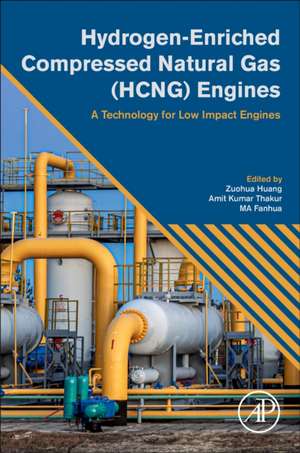Hydrogen-Enriched Compressed Natural Gas (HCNG) Engines: A Technology for Low Impact Engines
Autor Ma Fanhua, Zuohua Huang, Amit Kumar Thakuren Limba Engleză Paperback – 30 apr 2023
Readers will take away a thorough understanding of spark ignition engines and the effect of fuel composition on their general behavior, considering emissions, efficiency and performance improvement.
- Presents the fundamentals of HCNG engines and the relative effect on combustion, performance and emissions
- Covers the numerical modeling of HCNG engines and includes a full lifecycle assessment
- Includes a section completely dedicated to direct injection into the combustion chamber
Preț: 800.46 lei
Preț vechi: 1124.49 lei
-29% Nou
Puncte Express: 1201
Preț estimativ în valută:
153.19€ • 159.34$ • 126.46£
153.19€ • 159.34$ • 126.46£
Carte nepublicată încă
Doresc să fiu notificat când acest titlu va fi disponibil:
Se trimite...
Preluare comenzi: 021 569.72.76
Specificații
ISBN-13: 9780323904483
ISBN-10: 0323904483
Pagini: 300
Ilustrații: Approx. 100 illustrations
Dimensiuni: 152 x 229 mm
Editura: ELSEVIER SCIENCE
ISBN-10: 0323904483
Pagini: 300
Ilustrații: Approx. 100 illustrations
Dimensiuni: 152 x 229 mm
Editura: ELSEVIER SCIENCE
Cuprins
Section I Introduction
1. Introduction to HCNG engines
2. Background of HCNG engines
3. Impact on current transportation infrastructure
4. Challenges involved in HCNG adaptation
5. Fundamentals of HCNG
6. Physical Characteristics of HCNG
7. Experimental system and methodology
8. Laminar flame characteristics
9. Flammability limit
10. Flame propagation and dynamics
11. Early flame development
12. Performance characteristics of HCNG engine
13. Effect of compression ratio
14. Effect of spark timings
15. Effect of excess air ratio at idle conditions
16. Effect of wide open throttle operating conditions
17. Combustion and emission characteristics of HCNG engine
18. Effect of hydrogen addition on cycle-by cycle variations
19. Extension of Lean limit
20. Effect of Excess air ratio
21. Effect of spark timings
22. Reduction of idle speed
23. Engine combustion characteristics
24. Engine cycle-by-cycle variations
25. Engine emission characteristics
26. Effect of compression ratio on combustion, emissions and cyclic variations
27. Effect of fuel injection timings
28. Combustion and emission characteristics of DI HCNG engine
29. Application of direct injection in HCNG engines
30. Effect of fuel injection timing
31. Effect of hydrogen addition on emission
32. Effect of cyclic variability
Section II Optimization of HCNG engines-lean burn
33. Hydrogen ratio
34. Excess air ratio
35. Spark timings
36. Exhaust gas recycle (EGR)
37. Compression ratio
38. Extension of lean operation limit
39. Effect of hydrogen addition
40. Effect of engine load
41. Effect of engine speed
42. Effect of spark timing
43. Catalytic converters usage
Section III Optimization of HCNG engines-stoichiometric Combustion
44. Hydrogen ratio
45. Exhaust gas recycle (EGR)
46. Spark timings
47. TWC performance
Section IV Numerical modelling of HCNG engines
48. Statistical Analysis method
49. Overview
50. Design of experiments
51. Gaussian function modeling
52. Artificial Neural Network (ANN) optimization
53. ANN modeling to study the performance of HCNG engine
54. ANN modeling to study the emission of HCNG engine
55. Intelligent Regression Algorithm optimization
56. Support Vector Machine(SVM) method
57. Support Vector Machine(SVM) to study performance of HCNG engines
58. Support Vector Machine(SVM) to study NOx emission of HCNG engines
59. Quasi dimensional combustion model
60. Effect of calibration coefficients on the model
61. Two zone thermodynamic model
62. Turbulent entrainment combustion model
63. Adiabatic flame temperature model
64. Laminar burning velocity model
Section V Life Cycle Assessment of HCNG engines
65. Life Cycle Assessment of HCNG engines
66. Sources of Hydrogen Production
1. Introduction to HCNG engines
2. Background of HCNG engines
3. Impact on current transportation infrastructure
4. Challenges involved in HCNG adaptation
5. Fundamentals of HCNG
6. Physical Characteristics of HCNG
7. Experimental system and methodology
8. Laminar flame characteristics
9. Flammability limit
10. Flame propagation and dynamics
11. Early flame development
12. Performance characteristics of HCNG engine
13. Effect of compression ratio
14. Effect of spark timings
15. Effect of excess air ratio at idle conditions
16. Effect of wide open throttle operating conditions
17. Combustion and emission characteristics of HCNG engine
18. Effect of hydrogen addition on cycle-by cycle variations
19. Extension of Lean limit
20. Effect of Excess air ratio
21. Effect of spark timings
22. Reduction of idle speed
23. Engine combustion characteristics
24. Engine cycle-by-cycle variations
25. Engine emission characteristics
26. Effect of compression ratio on combustion, emissions and cyclic variations
27. Effect of fuel injection timings
28. Combustion and emission characteristics of DI HCNG engine
29. Application of direct injection in HCNG engines
30. Effect of fuel injection timing
31. Effect of hydrogen addition on emission
32. Effect of cyclic variability
Section II Optimization of HCNG engines-lean burn
33. Hydrogen ratio
34. Excess air ratio
35. Spark timings
36. Exhaust gas recycle (EGR)
37. Compression ratio
38. Extension of lean operation limit
39. Effect of hydrogen addition
40. Effect of engine load
41. Effect of engine speed
42. Effect of spark timing
43. Catalytic converters usage
Section III Optimization of HCNG engines-stoichiometric Combustion
44. Hydrogen ratio
45. Exhaust gas recycle (EGR)
46. Spark timings
47. TWC performance
Section IV Numerical modelling of HCNG engines
48. Statistical Analysis method
49. Overview
50. Design of experiments
51. Gaussian function modeling
52. Artificial Neural Network (ANN) optimization
53. ANN modeling to study the performance of HCNG engine
54. ANN modeling to study the emission of HCNG engine
55. Intelligent Regression Algorithm optimization
56. Support Vector Machine(SVM) method
57. Support Vector Machine(SVM) to study performance of HCNG engines
58. Support Vector Machine(SVM) to study NOx emission of HCNG engines
59. Quasi dimensional combustion model
60. Effect of calibration coefficients on the model
61. Two zone thermodynamic model
62. Turbulent entrainment combustion model
63. Adiabatic flame temperature model
64. Laminar burning velocity model
Section V Life Cycle Assessment of HCNG engines
65. Life Cycle Assessment of HCNG engines
66. Sources of Hydrogen Production
